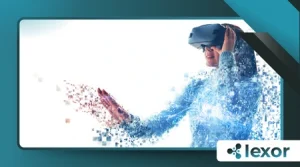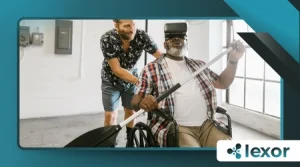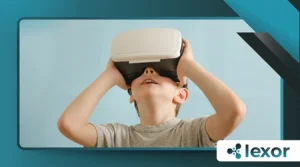Top Real-World Uses of Virtual Reality in 2025

The uses of virtual reality in 2025 have expanded far beyond gaming, integrating into healthcare, corporate training, retail, and even social connectivity.
With the global VR market projected to surpass $100 billion this year (Statista, 2024), the technology’s adoption is accelerating thanks to advancements in haptic feedback, artificial intelligence, and ultra-low-latency 5G networks.
But what makes VR truly revolutionary in 2025 isn’t just its technical prowess it’s the tangible impact on everyday life.
Surgeons practice complex procedures in zero-risk simulations, students explore ancient civilizations as if standing in them, and remote teams collaborate in virtual offices with lifelike presence.
The uses of virtual reality are solving real-world problems, from reducing chronic pain to democratizing education.
Consider this: Would you rather read about the Roman Colosseum or walk through its corridors, hearing the echoes of gladiators?
VR makes the latter possible, and this shift from passive consumption to active participation defines its power. Below, we explore the most groundbreaking uses of virtual reality today, backed by real data, case studies, and expert insights.
Revolutionizing Healthcare: Precision and Empathy
The healthcare sector has embraced VR not just as a training tool but as a therapeutic and diagnostic breakthrough. Leading hospitals now use VR simulations to prepare surgeons for rare and complex operations.
For example, Johns Hopkins recently conducted the first fully VR-planned brain surgery, reducing procedure time by 25% and minimizing risks.
The uses of virtual reality in surgery extend beyond preparation—real-time VR overlays during operations provide surgeons with 3D anatomical maps, improving precision.
Pain management has also seen a paradigm shift. Burn victims undergoing wound care often experience excruciating pain, but studies show that immersive VR environments can reduce perceived pain levels by up to 50% (Applied VR, 2023).
Patients immersed in calming virtual landscapes—such as a snow-covered forest or a serene beach—report significantly lower discomfort during treatments.
Mental health treatment is another frontier. VR-based exposure therapy helps veterans with PTSD confront traumatic memories in a controlled setting, gradually reducing anxiety.
++Best Educational Apps for Kids Aged 3 to 6
Clinics like Oxford VR have reported a 40% faster recovery rate compared to traditional methods. The uses of virtual reality in therapy demonstrate that sometimes, the best healing happens in a world that doesn’t physically exist.

Transforming Education: Immersive Learning Without Limits
Imagine a history class where students don’t just read about the French Revolution—they witness the storming of the Bastille in real-time, standing among the revolutionaries. This is the power of VR in education.
Stanford University’s Virtual Human Interaction Lab found that students retain 76% more information when learning in immersive environments compared to textbooks.
The uses of virtual reality in education are dismantling geographical and financial barriers, offering experiences once reserved for field trips or elite institutions.
Medical schools are at the forefront. Instead of relying solely on cadavers, students at institutions like Harvard Medical School now perform virtual dissections, exploring human anatomy in interactive 3D.
This method not only enhances understanding but also reduces costs associated with physical specimens. Similarly, engineering students manipulate holographic machinery, identifying flaws before real-world prototypes are built.
Corporate training has also evolved. Walmart’s VR onboarding program simulates high-pressure scenarios like holiday rushes, improving employee readiness without real-world consequences. A PwC study found that VR-trained employees learn four times faster than in traditional settings.
++Bitcoin vs Ethereum: What’s the Real Difference?
The uses of virtual reality in professional development prove that experiential learning isn’t just more engaging—it’s more effective.
Enterprise and Remote Work: The Virtual Office Revolution
The traditional office is fading, replaced by virtual workspaces where teams collaborate as if they were in the same room.
Platforms like Meta Horizon Workrooms and Microsoft Mesh enable 3D whiteboarding, spatial audio discussions, and even virtual coffee breaks.
The uses of virtual reality in enterprise are redefining productivity, particularly for global teams. A recent survey by Gartner revealed that 65% of remote employees using VR reported higher job satisfaction due to reduced isolation.
Architecture and engineering firms leverage VR to visualize projects before breaking ground.
For instance, Foster + Partners used VR to walk clients through unbuilt skyscrapers, identifying design tweaks early and saving millions in revisions. Similarly, automotive companies like Ford conduct virtual crash tests, accelerating R&D cycles.
Training is another critical application. Boeing now trains pilots in VR flight simulators that replicate extreme weather conditions with unprecedented realism.
The result? A 30% reduction in training time and a significant drop in costly real-flight practice hours. The uses of virtual reality in business are proving that the future of work isn’t just remote—it’s immersive.

Retail and E-Commerce: Try Before You Buy, Digitally
Online shopping’s biggest limitation the inability to physically interact with products is dissolving thanks to VR. IKEA’s VR app, for example, lets customers place true-to-scale furniture in their homes before purchasing.
The uses of virtual reality in retail are slashing return rates by up to 35%, according to a 2024 Shopify report.
Read more: Smart Bathrooms: Yes, They Exist — and They’re Amazing
Luxury brands are also capitalizing on VR’s experiential potential.
Gucci’s virtual fitting rooms allow shoppers to “try on” clothing via avatars, increasing conversion rates by 22% (Forbes, 2024). Even car buyers now take virtual test drives—Tesla’s VR showrooms have reduced the need for physical dealership visits by 40%.
The retail landscape is shifting from transactional to experiential.
Soon, shopping may not involve clicking “Add to Cart” but stepping into a digital boutique where products can be touched, rotated, and tested in real-time.
Entertainment Beyond Gaming: Live Experiences in VR
Gaming may have popularized VR, but entertainment now extends far beyond it.
Live concerts in VR attract millions Travis Scott’s Fortnite performance drew 12.3 million concurrent viewers, a record that hints at the future of events.
The uses of virtual reality in entertainment are creating shared experiences without physical limits.
Museums are also embracing VR. The Louvre’s virtual tours saw a 300% increase in attendance during the 2024 Paris Olympics, allowing global audiences to admire the Mona Lisa without queues.
Meanwhile, Netflix and Disney+ are experimenting with interactive VR films where viewers influence plot outcomes—imagine choosing a character’s next move and seeing the story adapt in real-time.
Sports fans aren’t left out. The NBA’s VR broadcasts offer courtside views from home, with viewership growing by 15% annually. The uses of virtual reality in media prove that passive watching is becoming an outdated concept.
Military and Defense: Training Without Risk
Combat training has entered a new era with hyper-realistic VR simulations.
The U.S. Army’s Synthetic Training Environment (STE) replicates battlefields down to weather patterns and terrain, preparing soldiers for scenarios too dangerous or expensive to recreate.
The uses of virtual reality in defense aren’t just about tactics—they’re about survival.
PTSD treatment is another critical application. Veterans undergoing VR exposure therapy at VA hospitals show a 45% improvement in symptom management compared to conventional methods.
By confronting trauma in a controlled virtual space, recovery becomes more manageable.
Even disaster response teams use VR. Firefighters train in virtual infernos, and paramedics practice triage in digital mass-casualty scenarios. The uses of virtual reality in high-stakes professions underscore its life-saving potential.
Real Estate: Selling Properties Before They’re Built
The real estate market thrives on visualization, and VR delivers it flawlessly. Buyers can tour homes remotely, inspecting every corner without travel.
Matterport’s 3D tours have cut sales cycles by 20%, with a 300% boost in client engagement (Matterport, 2024). The uses of virtual reality in real estate are eliminating guesswork for buyers and developers alike.
Architects also benefit. Zaha Hadid Architects use VR to walk clients through unbuilt skyscrapers, refining designs before construction begins. This process reduces costly revisions and accelerates approvals.
For investors, VR offers virtual property walkthroughs in emerging markets, enabling confident decisions from thousands of miles away.
The uses of virtual reality in real estate prove that seeing isn’t just believing—it’s buying.
Sports: Enhancing Performance and Fan Engagement
Athletes now train in VR to refine techniques without physical strain.
Quarterbacks like Patrick Mahomes use VR to simulate opposing defenses, improving decision-making speed by 17% (STRIVR, 2024). The uses of virtual reality in sports are turning practice into a data-driven science.
Fans also benefit. The NFL’s VR broadcasts let viewers choose camera angles, from quarterback vision to aerial drones. This interactivity has boosted engagement, with 60% of users returning for multiple games.
Even amateur athletes use VR. Golfers analyze swings in 3D, and runners visualize racecourses beforehand. The uses of virtual reality in athletics are democratizing elite-level training.
Accessibility: Breaking Physical Barriers
For individuals with disabilities, VR opens doors—literally. Wheelchair users can “hike” Machu Picchu, and the visually impaired navigate virtual cities with audio cues.
Microsoft’s Seeing AI integrates VR to describe surroundings in real-time. The uses of virtual reality in accessibility are granting freedoms once deemed impossible.
Social VR platforms like VRChat also combat isolation, allowing homebound users to interact in digital spaces.
A 2024 study found that 70% of users with mobility issues reported improved mental health after regular VR socialization.
The technology isn’t just about entertainment—it’s about empowerment.
Conclusion
The uses of virtual reality in 2025 are as diverse as they are transformative. From life-saving medical applications to boundary-free education, VR is no longer a novelty it’s a necessity.
The market’s explosive growth reflects its undeniable value, with industries racing to adopt immersive solutions.
But beyond statistics and case studies, VR’s true impact lies in its ability to connect, heal, and inspire. Will classrooms of the future be entirely virtual?
Will surgeons one day operate exclusively in digital realms? The answers are unfolding now. What’s certain is that the uses of virtual reality are rewriting human potential—one immersive experience at a time.
Frequently Asked Questions
How is VR being used in mental health treatment?
VR exposure therapy helps patients confront phobias and PTSD in controlled environments, with studies showing faster recovery rates than traditional methods.
Can VR replace physical classrooms?
While not a full replacement, VR enhances education by providing immersive, interactive learning experiences that improve retention and engagement.
What industries benefit most from VR?
Healthcare, education, enterprise, and entertainment are leading adopters, but retail, real estate, and defense are rapidly integrating VR solutions.
Is VR affordable for everyday consumers?
Prices have dropped significantly, with standalone headsets like Meta Quest 3 making VR accessible to mainstream users.
Will VR replace in-person social interactions?
Unlikely—instead, VR complements real-world connections by enabling interactions across distances and for those with mobility limitations.
This deep dive into the uses of virtual reality in 2025 highlights a technology that’s not just evolving—it’s revolutionizing how we live, work, and connect. The future isn’t on the horizon; it’s already here, and it’s virtual.
